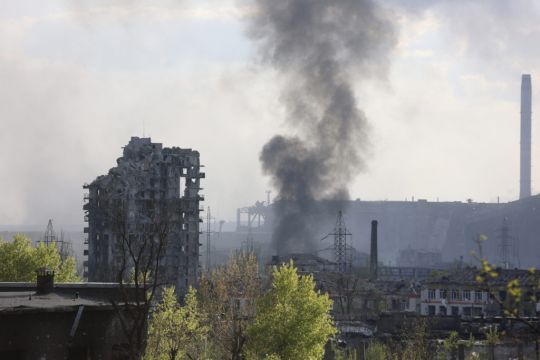Ukraine’s military said it has recaptured areas in the south and repelled Russian attacks in the east as a battle rages at a steel mill in Mariupol – where Ukrainian troops are holed up in tunnels and bunkers fending off a Russian onslaught.
After 10 weeks of war, Ukrainian and Russian forces are fighting village by village as Moscow struggles to gain momentum in the eastern industrial heartland of the Donbas.
Russia switched its focus to that region – where Moscow-backed separatists have fought Ukrainian forces for years – after a stiffer-than-expected resistance bogged its troops down and thwarted its initial goal of overrunning the capital Kyiv.
In addition to heavy shelling of the Donbas, Russian forces kept up their bombardment of railway stations and other supply-line targets across the country — part of an effort to disrupt the supply of western arms, which have been critical to Ukraine’s defence.
Ukrainian forces said they have made some gains on the border of the southern regions of Kherson and Mykolaiv and repelled 11 Russian attacks in the Donetsk and Luhansk regions that make up the Donbas.
Five people have been killed and at least 25 hurt in shelling of cities in the Donbas over the past 24 hours, Ukrainian officials said.
The attacks have also damaged houses and a school.
Air raid sirens sounded in cities across the country on Wednesday night, while Russian attacks were reported near Kyiv, in Cherkasy and Dnipro in central Ukraine, and in Zaporizhzhia in the south east.
In Dnipro, authorities said a rail facility was hit — following several earlier attacks on railway stations across the country.
The sirens sounded anew early on Thursday in the western city of Lviv, which has been a gateway for western arms and served as a relative safe haven for people fleeing fighting farther east.

An assessment by the Washington-based Institute for the Study of War said Russian forces are struggling to gain traction.
“Ukrainian defences have largely stalled Russian advances in eastern Ukraine,” it said late on Wednesday.
“Russian forces intensified airstrikes against transportation infrastructure in western Ukraine (on Wednesday) but remain unable to interdict western aid shipments to Ukraine,” it added.
In the most searing example of how Ukrainian forces have slowed Russia’s progress, Ukrainian fighters have held out at the sprawling Azovstal steel mill in Mariupol — the last pocket of resistance in a city that is otherwise controlled by Moscow’s forces.
“With the support of aircraft, the enemy resumed the offensive in order to take control of the plant,” the Ukrainian military’s General Staff said on Thursday.
A stream of black smoke rose above the plant on Wednesday.
Latest Defence Intelligence update on the situation in Ukraine - 05 May 2022
Find out more about the UK government's response: https://t.co/redhrfv2PC
🇺🇦 #StandWithUkraine 🇺🇦 pic.twitter.com/5gt1p5MeT6— Ministry of Defence 🇬🇧 (@DefenceHQ) May 5, 2022
The Ukrainians say Russian forces have pushed into the plant’s perimeter and are bombing it from above.
The Kremlin denied there is any ground assault.
Denys Prokopenko, commander of the Ukrainian Azov regiment that is defending the plant, said in a video posted on Wednesday that the incursions continued for a second day “and there are heavy, bloody battles”.
Mariupol’s fall would deprive Ukraine of a vital port, allow Russia to establish a land corridor to the Crimean Peninsula, which it seized from Ukraine in 2014, and free up troops to fight elsewhere in the Donbas.
The city, and the plant in particular, have come to symbolise the misery inflicted by the war.
The Russians have pulverised most of Mariupol in a two-month siege that has trapped civilians with little food, water, medicine or heat.
Civilians holed up inside the plant have perhaps suffered even more.
About 100 of them were evacuated over the weekend — the first time some saw daylight in months.
The Russian government said it would open another evacuation corridor from the plant during certain hours on Thursday through to Saturday.
But there was no immediate confirmation of those arrangements from other parties, and many previous assurances from the Kremlin have fallen through, with the Ukrainians blaming continued fighting by the Russians.
It is unclear how many Ukrainian fighters are still inside the plant but the Russians put the number at about 2,000 in recent weeks, with 500 reported to be hurt.
A few hundred civilians also remain there, the Ukrainian side said this week.

The United Nations announced that more than 300 civilians were evacuated from Mariupol and other nearby communities on Wednesday.
The evacuees arrived in Zaporizhzhia, about 140 miles to the north west, where they were receiving humanitarian assistance.
“Many came with nothing but the clothes they were wearing and we will now support them during this difficult time, including with much-needed psychological support,” said Osnat Lubrani, the UN humanitarian co-ordinator for Ukraine.
Meanwhile, Belarus, which Russia used as a staging ground for its invasion, announced the start of military exercises on Wednesday.
A top Ukrainian official said the country will be ready to act if Belarus joins the fighting.
Britain’s Ministry of Defence said on Thursday it does not believe the drills pose a threat to Ukraine, though is suspects Moscow will use them “to fix Ukrainian forces in the north, preventing them from being committed to the battle for the Donbas”.

In addition to supplying weapons to Ukraine, Europe and the US have sought to punish Moscow with sanctions, taking aim at the country’s vital energy sector.
The European Union’s top official called on the 27-nation bloc on Wednesday to ban Russian oil imports, a crucial source of revenue.
The proposal needs unanimous approval from EU countries and is likely to be debated fiercely.
Hungary and Slovakia have already said they won’t take part in any oil sanctions but they could be granted an exemption.
The EU is also talking about a possible embargo on Russian natural gas.
The bloc has already approved a cut-off of coal imports.







